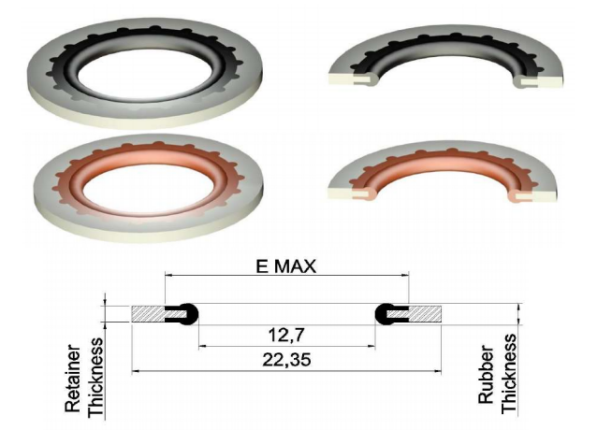rear axle oil seal replacement
Rear Axle Oil Seal Replacement A Comprehensive Guide
The rear axle oil seal plays a crucial role in maintaining the integrity of your vehicle's rear axle assembly. This small but significant component prevents oil from leaking out of the housing, ensuring proper lubrication and functioning of the gears inside. Over time, wear and tear can cause these seals to degrade, leading to oil leaks that can result in serious mechanical issues. In this article, we will guide you through the process of replacing a rear axle oil seal, helping you extend the lifespan of your vehicle.
Understanding the Importance of the Rear Axle Oil Seal
The rear axle oil seal is designed to keep the lubricant contained within the axle housing, preventing it from leaking out and ensuring that the gears are adequately lubricated. If the seal fails, it can result in a loss of lubricant, leading to increased friction, overheating, and potential damage to the axle components. Furthermore, oil leaks can create a hazard on the road, as they can make the surface slippery and pose a danger to other drivers.
Signs of a Failing Rear Axle Oil Seal
Before we delve into the replacement process, it’s essential to recognize the signs that indicate your rear axle oil seal may need replacement
1. Oil Spots or Puddles If you notice oil spots on your driveway or garage floor beneath your vehicle, it could be a sign of a leaking oil seal. 2. Low Oil Levels Frequently checking and topping off rear axle oil may indicate that the seal is not holding properly. 3. Unusual Noises Grinding or whining noises coming from the rear axle could signal a lubricant deficiency due to a leaking seal.
4. Increased Heat Overheating components can be a sign of inadequate lubrication, which may stem from a failing seal.
Tools and Materials Needed
Before starting the replacement process, gather the necessary tools and materials
- New rear axle oil seal - Socket set and ratchet - Wrench set - Hammer - Seal puller (optional, but helpful) - Slide hammer (if necessary) - Clean rags - Rear axle lubricant - Safety goggles and gloves
Step-by-Step Replacement Process
rear axle oil seal replacement

1. Safety First Park your vehicle on a flat, stable surface and engage the parking brake. Use wheel chocks if necessary, and ensure that you are wearing your safety gear.
2. Remove the Wheel Loosen the lug nuts and remove the wheel to access the axle hub.
3. Drain the Differential Fluid Place a drain pan underneath the differential and remove the cover or plug to drain the old fluid. Make sure to dispose of it properly as per local regulations.
4. Remove the Axle Depending on your vehicle model, you may need to disconnect the suspension components or other parts to access the axle. Remove any retaining clips and carefully slide the axle out of the housing.
5. Remove the Old Seal Using a seal puller or a hammer and chisel, carefully pry out the old oil seal from its housing. Be cautious not to damage the surrounding components.
6. Install the New Seal Lubricate the outer edge of the new seal with a bit of axle oil to help it slide into place. Use a seal installation tool or a flat, soft-faced hammer to tap it into position evenly.
7. Reassemble the Axle Once the new seal is in place, reinsert the axle into the housing, making sure it sits correctly. Reattach any suspension components and the wheels.
8. Refill the Differential Fluid Add the appropriate type and amount of differential oil through the fill hole. Consult your vehicle’s manual for specifications.
9. Test Drive After reassembling everything, take your vehicle for a short test drive. Check for any leaks or unusual noises. If everything seems normal, you successfully replaced the rear axle oil seal!
Conclusion
Replacing the rear axle oil seal is a straightforward process that can save you from more extensive and costly repairs down the road. By following the steps outlined above, you can ensure the longevity of your vehicle's rear axle and maintain optimal performance. Remember, if you're ever uncertain or uncomfortable performing this task, consider consulting a professional mechanic for assistance. With proper care and maintenance, you can keep your vehicle running smoothly for years to come.
-
Understanding the Front Main Engine Seal: Purpose, Maintenance, and Installation
News Jul.29,2025
-
Understanding O-Rings and Seal Rings: Types, Applications, and Custom Solutions
News Jul.29,2025
-
Understanding Crankshaft Oil Seals: Rear Seals, Pulley Seals, and Their Role in Engine Integrity
News Jul.29,2025
-
The Importance of Front and Rear Crankshaft Seals in Engine Performance and Oil Management
News Jul.29,2025
-
Crank Oil Seals: Functions, Types, and Cost Considerations in Engine Maintenance
News Jul.29,2025
-
A Comprehensive Guide to O-Rings and Seals: Types, Materials, and Global Applications
News Jul.29,2025
-
Mastering Diesel and Performance Engine Maintenance: A Guide to Critical Oil Gaskets
News Jul.28,2025
Products categories















